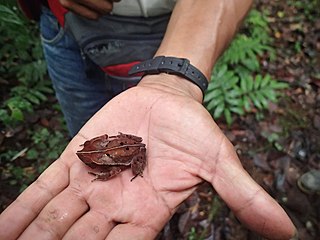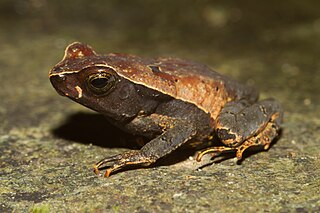
The Carchi Andes toad is a species of toad endemic to the western slopes of the Andes in northern Ecuador and southern Colombia. It is listed as an endangered species due to a restricted range and habitat loss.

Atelopus longirostris is a species of harlequin frog, a member of the family of true toads (Bufonidae). It has been recorded only in northern Ecuador. Records from Colombia probably represent different species. Once listed as extinct by the IUCN, it was rediscovered in 2016 after more than two decade with no sightings.

Adenomus kandianus is a species of toad in the family Bufonidae endemic to Sri Lanka. It is a high-altitude species known only from few localities. The specific name kandianus means "from Kandy" and seems to suggest that the type material came from near the city of Kandy.

Adenomus kelaartii is a species of toad in the family Bufonidae. It is endemic to Sri Lanka, where it is found in the south-west of the island at elevations between 30 and 1,230 m. The specific name kelaartii honours Edward Frederick Kelaart, a Ceylonese-born physician and zoologist.
The Western Andes toad is a species of toad in the family Bufonidae endemic to Colombia, where it is only known from the type locality in the Munchique National Natural Park, on the western slope of the Cordillera Occidental, Cauca. Its natural habitat is primary Andean forest.
Rhaebo olallai is a species of toad in the family Bufonidae endemic to Ecuador. Its common name is Tandayapa Andes toad, after its type locality, Tandayapa, in the Pichincha Province); the species has not been seen there after 1970, despite search efforts. It is only known from another locality in the Imbabura Province of Ecuador. It has also been reported from one locality on the Colombian Massif, Nariño Department, Colombia, but these have been shown to represent Rhaebo colomai.

Ansonia leptopus is a species of toad in the family Bufonidae. It is known from a few lowland localities in Borneo, Sumatra (Indonesia), and Peninsular Malaysia; it is reported as common in lowland Malaysian Borneo. Its presence in Peninsular Malaysia is uncertain. Its common names are brown slender toad, Matang stream toad, and cricket-voiced toad.
Atelopus subornatus is a species of toad in the family Bufonidae. It is endemic to Colombia and is restricted to the Cordillera Oriental in the Cundinamarca Department. Common name Bogota stubfoot toad has been coined for this species.
Blomberg's toad, also known as the Colombian giant toad, is a very large species of toad in the family Bufonidae. It is found in rainforests at altitudes between 200 and 650 metres in western Colombia and northwestern Ecuador. It has been recorded in Florida in 1963, apparently because of pet escape or release, but did not get established.

Rhaebo caeruleostictus is a species of toad in the family Bufonidae. It is endemic to Ecuador and occurs along the lower western slope of the Cordillera Occidental at elevations of 40–2,000 m (130–6,560 ft) asl. The specific name caeruleostictus, from Latin caeruleus (=blue) and Greek stiktos (spotted), refers to the bluish colour pattern of this species. Accordingly, common name blue-spotted toad has been coined for it.

The smooth-sided toad or spotted toad, formerly known as Bufo guttatus, is a species of toad in the family Bufonidae. It is found in the Amazonian Bolivia, Brazil, Colombia, Ecuador, Peru, and Venezuela, as well as the Guianas. Specimens from southern Peru, Bolivia, and Brazil might represent Rhaebo ecuadorensis described in 2012.
Rhaebo hypomelas is a species of toad in the family Bufonidae. It is endemic to Colombia and known from the Chocó region in the departments of Antioquia, Chocó, Risaralda, Valle del Cauca, and Cauca, at elevations of 10–1,600 m (33–5,249 ft) asl. There are also reports from Ecuador but these are not considered valid. Its natural habitats are lowland tropical moist forests. It is a terrestrial species living in leaf litter near water. It is a rare species that is threatened by habitat loss.
Werner's toad is a species of toad in the family Bufonidae. It is found in northwestern Guyana and eastern Venezuela at elevations of 500–1,350 m (1,640–4,430 ft) asl.

Rhinella poeppigii is a species of toad in the family Bufonidae that is known from the eastern Andean slopes of Ecuador, Peru, and Bolivia, as well as from Serranía de Sira in Amazonian Peru. Its distinctiveness from Rhinella marina has been debated, but it is currently accepted as a valid species. It is named after Eduard Friedrich Poeppig, German botanist and naturalist who made scientific expeditions to South America.

Rhinella roqueana is a species of toad in the family Bufonidae. It is found in northern Peru, eastern Ecuador (Pastaza), Amazonian Colombia, and adjacent western Brazil. Its specific name refers to its type locality, Roque, San Martín Region, Peru. Its taxonomic position is uncertain and it is not clear how to distinguish it from other members in the Rhinella margaritifera group in the area.
Melanophryniscus macrogranulosus is a species of toad in the family Bufonidae. It is endemic to northeastern Rio Grande do Sul, southern Brazil. It was for a long time only known from the type series collected in 1960, until another population was discovered in 2004. This was followed by the rediscovery of population at the type locality as well as few other populations, all in Rio Grande do Sul. Its common name is Torres redbelly toad, after the type locality.
Nectophrynoides pseudotornieri is a species of toad in the family Bufonidae. It is endemic to the Uluguru Mountains in eastern Tanzania. Common names pseudo forest toad and false Tornier's viviparous toad have been proposed for it. Its specific name refers to its similarity to Nectophrynoides tornieri.
Rhinella ruizi is a species of toad in the family Bufonidae. It is endemic to the Cordillera Central in Antioquia, Colombia. The specific name ruizi honors Pedro Miguel Ruiz-Carranza, a Colombian herpetologist.

Rhaebo is a genus of true toads, family Bufonidae, from Central and South America. They are distributed from Honduras to northern South America including the Amazonian lowlands. Common name Cope toads has been suggested for them.
Atelopus nocturnus, also known as the nocturnal harlequin toad, is a species of frog in the family Bufonidae. It is endemic to Antioquia, Colombia, and only known from its type locality in Anorí, in the northern Cordillera Central. The specific name nocturnus refers to the nocturnality of this species, which is unusual among Atelopus.











